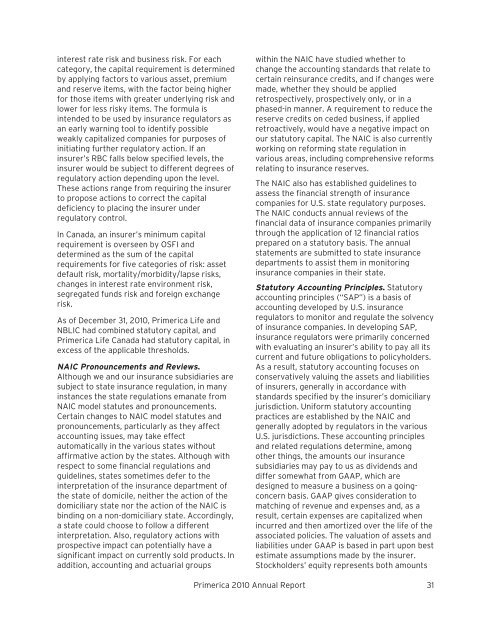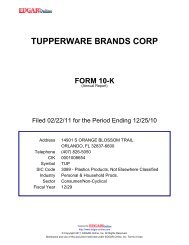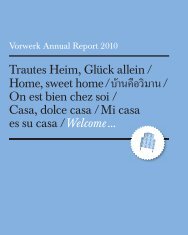directly or through any controlled entity orentities, a significant interest (i.e., more than10%) of any class of its shares. In consideringan application for a change of control of aninsurer, OSFI will consider the financialresources of the applicant, the soundness ofthe business plan presented by the applicant,and the business record, experience, characterand integrity of the applicant, as well aswhether the persons who will operate theinsurer after the change of control are suitablycompetent and experienced in the operation ofa financial institution and whether the changeof control is in the best interests of thepolicyholders and the Canadian financialsystem.These U.S. and Canadian laws regarding changeof control may discourage potential acquisitionproposals and may delay, deter or prevent achange of control involving us, includingthrough transactions, and in particularunsolicited transactions, that some or all of ourstockholders might consider to be desirable.Policy and Contract Reserve SufficiencyAnalysis. Under the laws and regulations oftheir jurisdictions of domicile, our U.S.insurance subsidiaries are required to conductannual analyses of the sufficiency of their lifeinsurance statutory reserves. In addition, otherU.S. jurisdictions in which these subsidiariesare licensed may have certain reserverequirements that differ from those of theirdomiciliary jurisdictions. In each case, aqualified actuary must submit an opinion thatstates that the aggregate statutory reserves,when considered in light of the assets held withrespect to such reserves, make good andsufficient provision for the associatedcontractual obligations and related expenses ofthe insurer. If such an opinion cannot beprovided, the affected insurer must set upadditional reserves by moving funds fromsurplus. Our U.S. insurance subsidiaries mostrecently submitted these opinions withoutqualification as of December 31, <strong>2010</strong> toapplicable insurance regulatory authorities.Our Canadian insurance subsidiary also isrequired to conduct regular analyses of thesufficiency of its life insurance statutoryreserves. Life insurance reserving andreporting requirements are completed by ourCanadian insurance subsidiary’s appointedactuary. Materials provided by the appointedactuary are filed with OSFI as part of ourannual filing and are subject to OSFI’s review.Based upon this review, OSFI may instituteremedial action against our Canadian insurancesubsidiary as OSFI deems necessary. OurCanadian insurance subsidiary has not beensubject to any such remediation orenforcement by OSFI.Surplus and Capital Requirements. U.S.insurance regulators have the discretionaryauthority, in connection with the ongoinglicensing of our U.S. insurance subsidiaries, tolimit or prohibit the ability of an insurer to issuenew policies if, in the regulators’ judgment, theinsurer is not maintaining a minimum amountof surplus or is in hazardous financial condition.Insurance regulators may also limit the abilityof an insurer to issue new life insurance policiesand annuity contracts above an amount basedupon the face amount and premiums of policiesof a similar type issued in the prior year. We donot believe that the current or anticipatedlevels of statutory surplus of our U.S. insurancesubsidiaries present a material risk that anysuch regulator would limit the amount of newpolicies that our U.S. insurance subsidiariesmay issue.In Canada, OSFI has authority to request aninsurer to enter into a prudential agreementimplementing measures to maintain or improvethe insurer’s safety and soundness. OSFI alsomay issue orders to an insurer directing it torefrain from unsafe or unsound practices or totake action to remedy financial concerns. OSFIhas neither requested that our Canadianinsurance subsidiary enter into any prudentialagreement nor has OSFI issued any orderagainst our Canadian insurance subsidiary.Risk-Based Capital and Minimum CapitalRequirements. The NAIC has establishedRisk-Based Capital (“RBC”) standards for U.S.life insurance companies, as well as a model actto be applied at the state level. The model actprovides that life insurance companies mustsubmit an annual RBC report to stateregulators reporting their RBC based upon fourcategories of risk: asset risk, insurance risk,30 Freedom Lives Here
interest rate risk and business risk. For eachcategory, the capital requirement is determinedby applying factors to various asset, premiumand reserve items, with the factor being higherfor those items with greater underlying risk andlower for less risky items. The formula isintended to be used by insurance regulators asan early warning tool to identify possibleweakly capitalized companies for purposes ofinitiating further regulatory action. If aninsurer’s RBC falls below specified levels, theinsurer would be subject to different degrees ofregulatory action depending upon the level.These actions range from requiring the insurerto propose actions to correct the capitaldeficiency to placing the insurer underregulatory control.In Canada, an insurer’s minimum capitalrequirement is overseen by OSFI anddetermined as the sum of the capitalrequirements for five categories of risk: assetdefault risk, mortality/morbidity/lapse risks,changes in interest rate environment risk,segregated funds risk and foreign exchangerisk.As of December 31, <strong>2010</strong>, <strong>Primerica</strong> Life andNBLIC had combined statutory capital, and<strong>Primerica</strong> Life Canada had statutory capital, inexcess of the applicable thresholds.NAIC Pronouncements and Reviews.Although we and our insurance subsidiaries aresubject to state insurance regulation, in manyinstances the state regulations emanate fromNAIC model statutes and pronouncements.Certain changes to NAIC model statutes andpronouncements, particularly as they affectaccounting issues, may take effectautomatically in the various states withoutaffirmative action by the states. Although withrespect to some financial regulations andguidelines, states sometimes defer to theinterpretation of the insurance department ofthe state of domicile, neither the action of thedomiciliary state nor the action of the NAIC isbinding on a non-domiciliary state. Accordingly,a state could choose to follow a differentinterpretation. Also, regulatory actions withprospective impact can potentially have asignificant impact on currently sold products. Inaddition, accounting and actuarial groupswithin the NAIC have studied whether tochange the accounting standards that relate tocertain reinsurance credits, and if changes weremade, whether they should be appliedretrospectively, prospectively only, or in aphased-in manner. A requirement to reduce thereserve credits on ceded business, if appliedretroactively, would have a negative impact onour statutory capital. The NAIC is also currentlyworking on reforming state regulation invarious areas, including comprehensive reformsrelating to insurance reserves.The NAIC also has established guidelines toassess the financial strength of insurancecompanies for U.S. state regulatory purposes.The NAIC conducts annual reviews of thefinancial data of insurance companies primarilythrough the application of 12 financial ratiosprepared on a statutory basis. The annualstatements are submitted to state insurancedepartments to assist them in monitoringinsurance companies in their state.Statutory Accounting Principles. Statutoryaccounting principles (“SAP”) is a basis ofaccounting developed by U.S. insuranceregulators to monitor and regulate the solvencyof insurance companies. In developing SAP,insurance regulators were primarily concernedwith evaluating an insurer’s ability to pay all itscurrent and future obligations to policyholders.As a result, statutory accounting focuses onconservatively valuing the assets and liabilitiesof insurers, generally in accordance withstandards specified by the insurer’s domiciliaryjurisdiction. Uniform statutory accountingpractices are established by the NAIC andgenerally adopted by regulators in the variousU.S. jurisdictions. These accounting principlesand related regulations determine, amongother things, the amounts our insurancesubsidiaries may pay to us as dividends anddiffer somewhat from GAAP, which aredesigned to measure a business on a goingconcernbasis. GAAP gives consideration tomatching of revenue and expenses and, as aresult, certain expenses are capitalized whenincurred and then amortized over the life of theassociated policies. The valuation of assets andliabilities under GAAP is based in part upon bestestimate assumptions made by the insurer.Stockholders’ equity represents both amounts<strong>Primerica</strong> <strong>2010</strong> <strong>Annual</strong> <strong>Report</strong> 31
- Page 1 and 2: Freedom Lives Here 2010 Annual Repo
- Page 3 and 4: A Main Street Company for Main Stre
- Page 5 and 6: North America’s vastmiddle-income
- Page 7 and 8: More than 50 percent of U.S. househ
- Page 9 and 10: We are PrimericaPrimerica is a Main
- Page 11 and 12: Primerica helps familiescreate a fi
- Page 13 and 14: René Turner wasalways told growing
- Page 15 and 16: We teach people how money works.We
- Page 19 and 20: UNITED STATESSECURITIES AND EXCHANG
- Page 21 and 22: CAUTIONARY STATEMENT CONCERNING FOR
- Page 23 and 24: PART IITEM 1.BUSINESSOverviewPrimer
- Page 25 and 26: them reduce and ultimately pay off
- Page 27 and 28: With the support of our home office
- Page 29 and 30: ecognized with the sales representa
- Page 31 and 32: force. We also profile successful s
- Page 33 and 34: • bonuses and other compensation,
- Page 35 and 36: originators (and in some states as
- Page 37 and 38: We organize and manage our business
- Page 39 and 40: premiums that are less per person p
- Page 41 and 42: insurance policies that we underwri
- Page 43 and 44: assistance, has developed a series
- Page 45 and 46: SEC, FINRA and with respect to 529
- Page 47 and 48: they sell insurance policies. Our C
- Page 49: preceding 12 months, exceed this st
- Page 53 and 54: operational support to its subsidia
- Page 55 and 56: Privacy of Consumer Information. U.
- Page 57 and 58: media. This negative commentary can
- Page 59 and 60: with such laws and regulations, inc
- Page 61 and 62: and disrupt the economy. Although w
- Page 63 and 64: Our financial strength and credit r
- Page 65 and 66: There are certain risks and uncerta
- Page 67 and 68: 26). The update revises the definit
- Page 69 and 70: conduct standards prescribed by FIN
- Page 71 and 72: licensing requirements have caused,
- Page 73 and 74: Terrorist Financing Act and its acc
- Page 75 and 76: educing dividends or other amounts
- Page 77 and 78: housed at our Duluth and Roswell, G
- Page 79 and 80: • for dates as of or periods endi
- Page 81 and 82: to and subject to the limitations o
- Page 83 and 84: Field Audit Department from 1993 to
- Page 85 and 86: Securities Authorized for Issuanceu
- Page 87 and 88: ITEM 6.SELECTED FINANCIAL DATA.The
- Page 89 and 90: pursuant to which we issued to a wh
- Page 91 and 92: ecruiting boost we experienced in t
- Page 93 and 94: • Mortality. We use historical ex
- Page 95 and 96: • sales of a higher proportion of
- Page 97 and 98: on quality rating, average life and
- Page 99 and 100: Deferred Policy Acquisition Costs(D
- Page 101 and 102:
life insurance processing responsib
- Page 103 and 104:
einsurance agreements impacted the
- Page 105 and 106:
Notes to the Pro Forma Statement of
- Page 107 and 108:
Term Life Insurance Segment ProForm
- Page 109 and 110:
Investments and Savings ProductsSeg
- Page 111 and 112:
We believe that the pro forma resul
- Page 113 and 114:
ecognized in 2008. Excluding the ef
- Page 115 and 116:
amortize the higher DAC balance res
- Page 117 and 118:
Corporate and Other DistributedProd
- Page 119 and 120:
The composition of our invested ass
- Page 121 and 122:
LIQUIDITY AND CAPITALRESOURCESDivid
- Page 123 and 124:
surplus notes, hybrid securities or
- Page 125 and 126:
ITEM 7A. QUANTITATIVE ANDQUALITATIV
- Page 127 and 128:
AssetsPRIMERICA, INC. AND SUBSIDIAR
- Page 129 and 130:
PRIMERICA, INC. AND SUBSIDIARIESCon
- Page 131 and 132:
PRIMERICA, INC. AND SUBSIDIARIESCon
- Page 133 and 134:
which we are able to reinvest at ou
- Page 135 and 136:
with reinsured policies. Ceded poli
- Page 137 and 138:
indemnify and hold the Company harm
- Page 139 and 140:
New Accounting PrinciplesScope Exce
- Page 141 and 142:
immediately contributed back to us
- Page 143 and 144:
The Investment and Savings Products
- Page 145 and 146:
(4) InvestmentsOn March 31, 2010, w
- Page 147 and 148:
The following tables summarize, for
- Page 149 and 150:
The net effect on stockholders’ e
- Page 151 and 152:
The amortized cost and fair value o
- Page 153 and 154:
The roll-forward of credit-related
- Page 155 and 156:
having similar tenors (e.g., sector
- Page 157 and 158:
(5) Financial InstrumentsThe carryi
- Page 159 and 160:
Due from reinsurers includes ceded
- Page 161 and 162:
(8) Intangible Assets and GoodwillT
- Page 163 and 164:
(11) Note PayableIn April 2010, we
- Page 165 and 166:
Income tax expense (benefit) attrib
- Page 167 and 168:
above, plus an additional 7,098 com
- Page 169 and 170:
Non-Employee Share-BasedTransaction
- Page 171 and 172:
We had arrangements with Citi in re
- Page 173 and 174:
Contingent LiabilitiesThe Company i
- Page 175 and 176:
ITEM 9. CHANGES IN ANDDISAGREEMENTS
- Page 177 and 178:
Members of Our Board of DirectorsTh
- Page 179 and 180:
finance, and risk and asset managem
- Page 181 and 182:
PART IVITEM 15. EXHIBITS AND FINANC
- Page 183 and 184:
10.4 Long-Term Services Agreement d
- Page 185 and 186:
10.29 Employment Agreement, dated a
- Page 187 and 188:
Schedule ISummary of Investments
- Page 189 and 190:
Schedule IICondensed Financial Info
- Page 191 and 192:
Schedule IICondensed Financial Info
- Page 193 and 194:
101% of the outstanding principal a
- Page 195 and 196:
GrossamountSchedule IVReinsurancePR
- Page 197 and 198:
Annual MeetingThe annual meeting of









